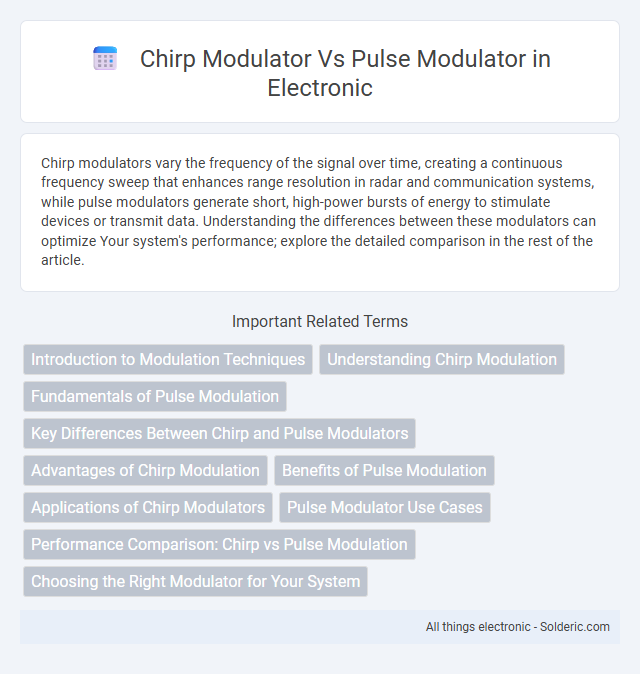Chirp modulators vary the frequency of the signal over time, creating a continuous frequency sweep that enhances range resolution in radar and communication systems, while pulse modulators generate short, high-power bursts of energy to stimulate devices or transmit data. Understanding the differences between these modulators can optimize Your system's performance; explore the detailed comparison in the rest of the article.
Comparison Table
| Feature | Chirp Modulator | Pulse Modulator |
|---|---|---|
| Modulation Type | Frequency modulation with time-varying frequency (chirp) | Amplitude modulation using on/off pulses |
| Signal Characteristics | Frequency sweeps continuously over pulse duration | Discrete pulses of fixed amplitude and duration |
| Applications | Radar, sonar, spread spectrum, communication systems | Radar transmitters, digital communication, pulsed systems |
| Bandwidth Utilization | Wide bandwidth due to frequency sweeping | Narrower bandwidth limited to pulse spectral content |
| Range Resolution | High resolution due to pulse compression | Lower resolution, dependent on pulse width |
| Complexity | Higher complexity in generation and processing | Simple generation and processing |
| Energy Efficiency | Efficient due to spread energy over time | Variable, depends on pulse duty cycle |
| Signal-to-Noise Ratio (SNR) | Improved SNR via pulse compression and correlation | Standard SNR, no pulse compression gain |
Introduction to Modulation Techniques
Chirp modulators vary the frequency of a carrier signal over time, creating a continuously changing frequency sweep ideal for radar and communication systems requiring high resolution and range. Pulse modulators generate discrete, time-limited pulses to transmit information, commonly used in radar and digital communication for precise timing and signal clarity. Both techniques optimize signal transmission but differ in time-frequency characteristics, offering trade-offs between resolution and simplicity.
Understanding Chirp Modulation
Chirp modulation varies the frequency of a signal continuously over time, enhancing signal detection and resolution in radar and communication systems. Unlike pulse modulation, which transmits discrete bursts of energy at fixed frequencies, chirp modulation enables better range resolution and Doppler tolerance due to its frequency sweep characteristics. This technique significantly improves performance in noisy environments by spreading the signal energy over a broader frequency band.
Fundamentals of Pulse Modulation
Pulse modulation involves varying specific properties of pulses, such as amplitude, width, or position, to encode information, whereas chirp modulation changes frequency within a pulse. Pulse modulation techniques include Pulse Amplitude Modulation (PAM), Pulse Width Modulation (PWM), and Pulse Position Modulation (PPM), each altering pulse characteristics to convey signals effectively. Chirp modulation specifically employs a continuous frequency sweep within a single pulse, enhancing range resolution and signal processing in radar and communication systems.
Key Differences Between Chirp and Pulse Modulators
Chirp modulators vary the frequency of the signal continuously over time, enabling better resolution and range in radar and communication systems, whereas pulse modulators generate short bursts of signals with fixed frequency and amplitude. Chirp modulation improves target identification by spreading energy across a bandwidth, while pulse modulation relies on time-domain separation of signals. Your choice depends on system requirements like resolution, bandwidth, and signal processing complexity.
Advantages of Chirp Modulation
Chirp modulation offers enhanced resistance to multipath fading and improved signal detection in noisy environments due to its frequency-swept waveform. This technique provides better range resolution and target identification compared to pulse modulation, making it ideal for radar and communication systems requiring high precision. Your system benefits from increased robustness and clarity, particularly in complex or cluttered operational settings.
Benefits of Pulse Modulation
Pulse modulation offers precise control over signal timing, enhancing bandwidth efficiency and reducing power consumption in communication systems. Its robustness against noise and interference improves signal integrity, making it ideal for radar and digital data transmission. The ability to encode information in discrete pulses enables greater flexibility for multiplexing and digital signal processing compared to chirp modulation.
Applications of Chirp Modulators
Chirp modulators are extensively used in radar systems, wireless communication, and ultrasonic imaging due to their ability to improve range resolution and reduce signal interference. They enable pulse compression techniques that enhance target detection accuracy and extend effective transmission distance in applications such as automotive radar and medical ultrasound. Pulse modulators, in contrast, are primarily employed where simple on-off keying or straightforward pulse shaping is required, making chirp modulators more suitable for advanced signal processing in cluttered environments.
Pulse Modulator Use Cases
Pulse modulators are extensively utilized in radar systems for precise timing and high power delivery, enabling accurate target detection and range measurement. They are crucial in medical devices such as ultrasound imaging, where short, intense pulses produce high-resolution images. Industrial applications also benefit from pulse modulators in laser systems for cutting and welding due to their ability to generate controlled energy bursts.
Performance Comparison: Chirp vs Pulse Modulation
Chirp modulators offer superior performance in range resolution and signal-to-noise ratio compared to pulse modulators, making them ideal for radar and communication systems requiring high accuracy. Pulse modulators generate short bursts of constant amplitude signals, which can suffer from limited resolution and increased susceptibility to noise. Your choice depends on system requirements, with chirp modulation excelling in environments demanding enhanced detection and discrimination capabilities.
Choosing the Right Modulator for Your System
Selecting the ideal modulator for your system hinges on signal requirements and application context; chirp modulators excel in radar and communication systems requiring high resolution and Doppler tolerance, while pulse modulators suit applications demanding precise timing and high peak power. Chirp modulation offers superior bandwidth efficiency and robustness against multipath interference, enhancing signal clarity in complex environments. Pulse modulators provide straightforward implementation and effectiveness in time-domain operations, making them suitable for pulsed laser systems and switching circuits.
Chirp modulator vs pulse modulator Infographic

 solderic.com
solderic.com